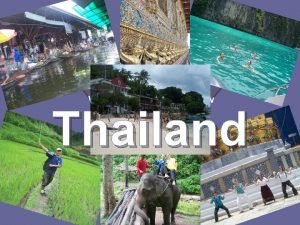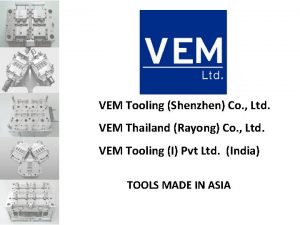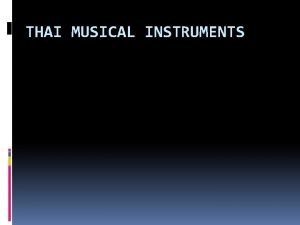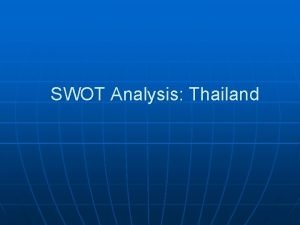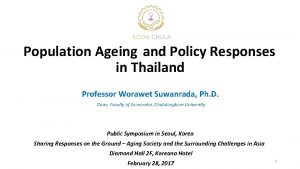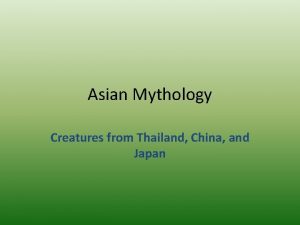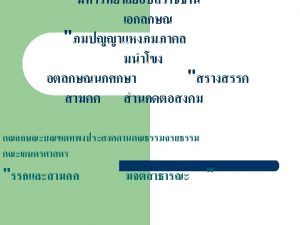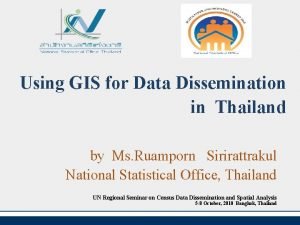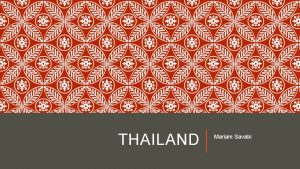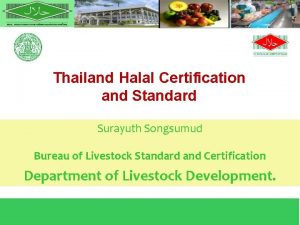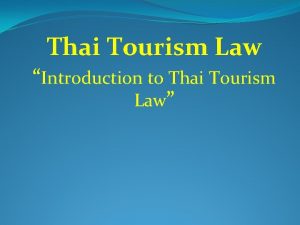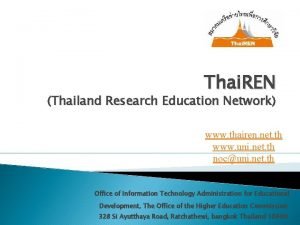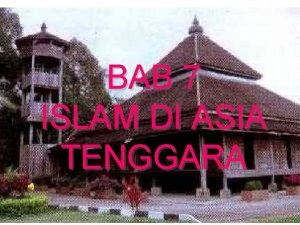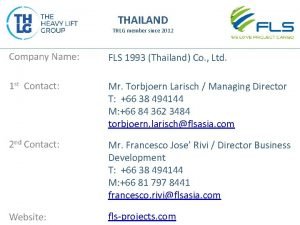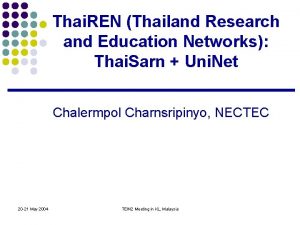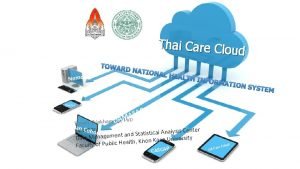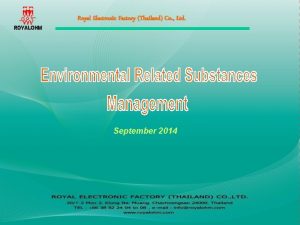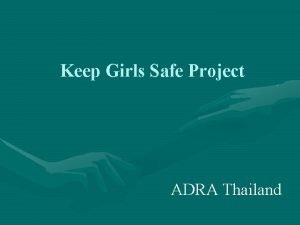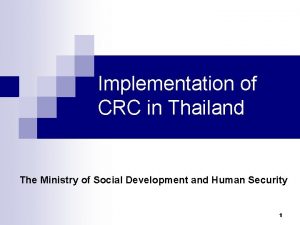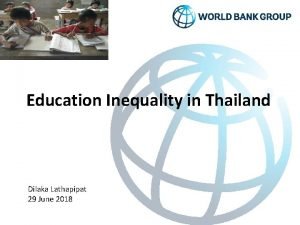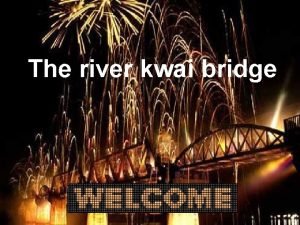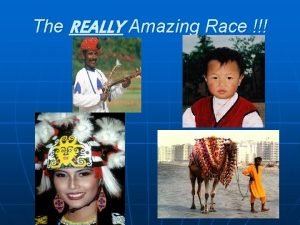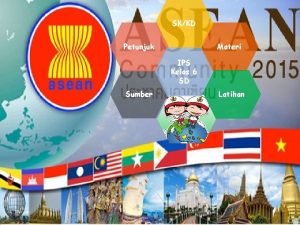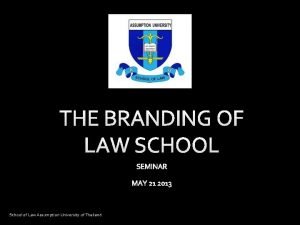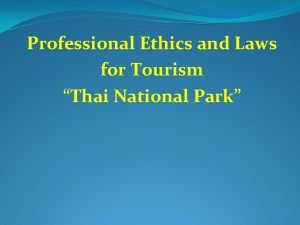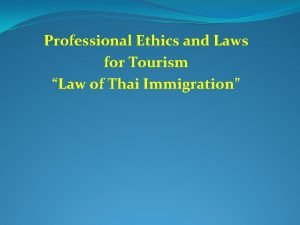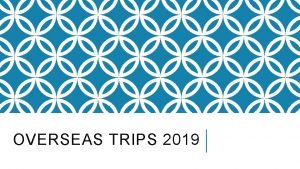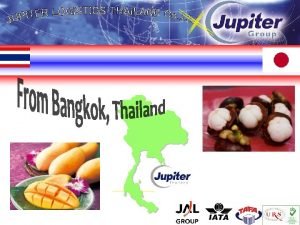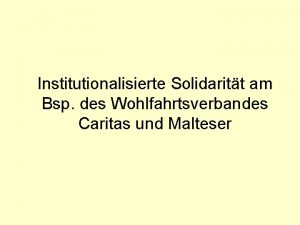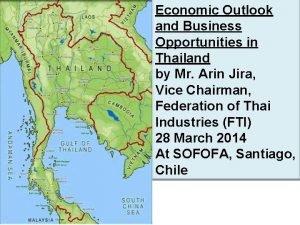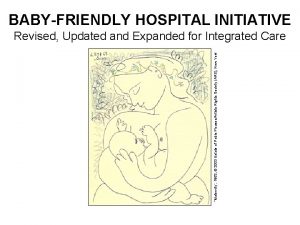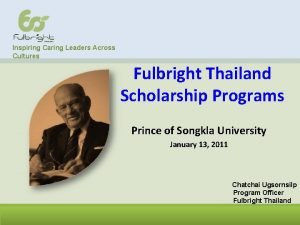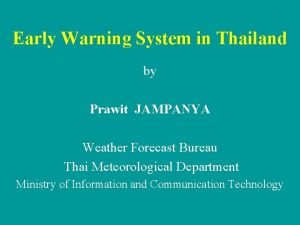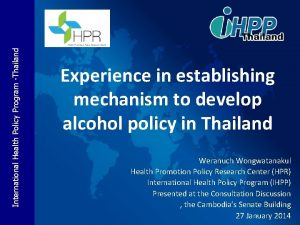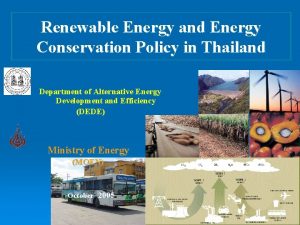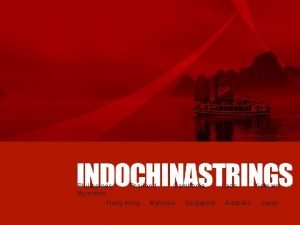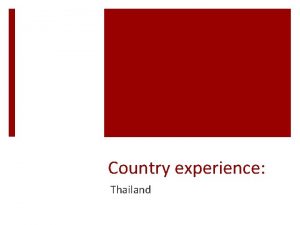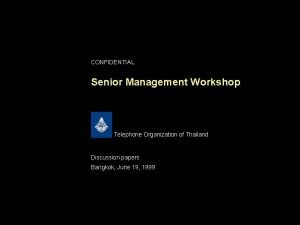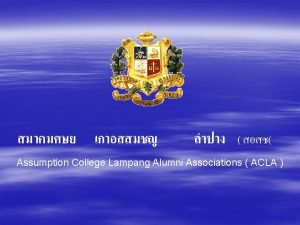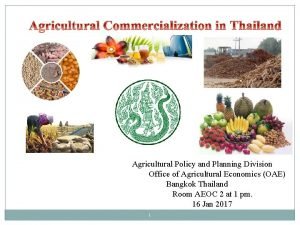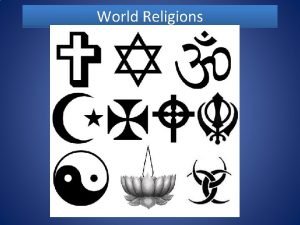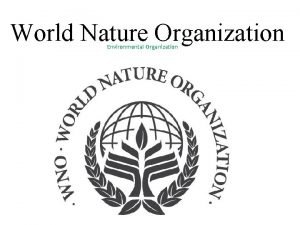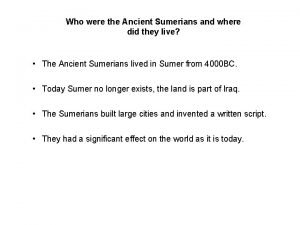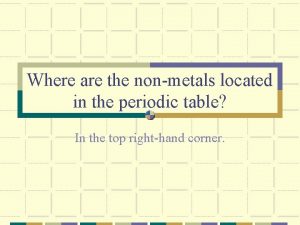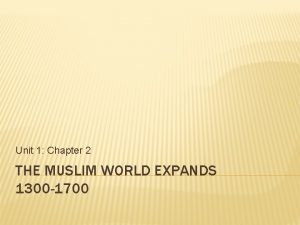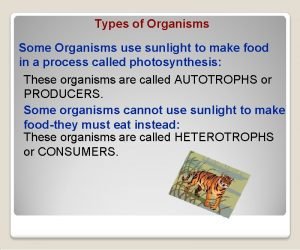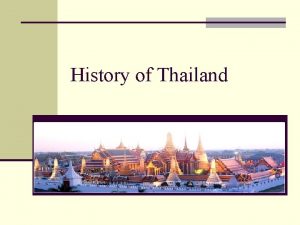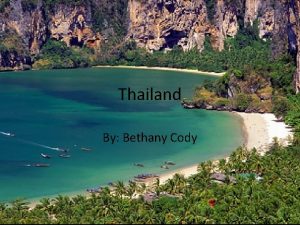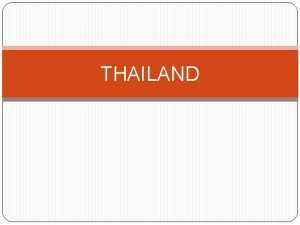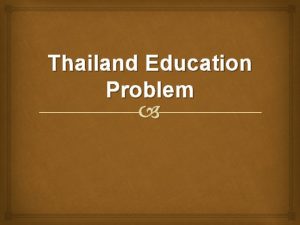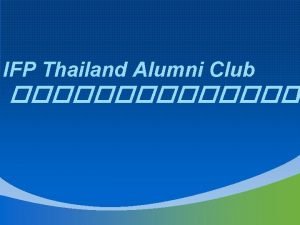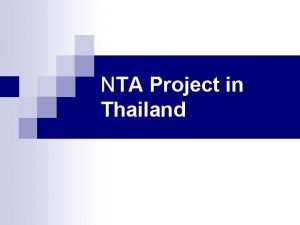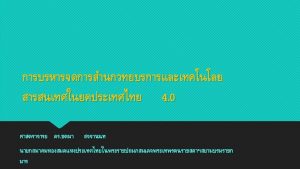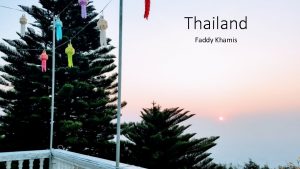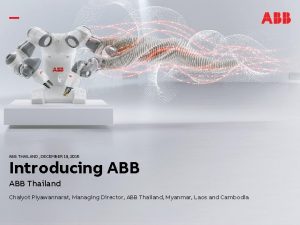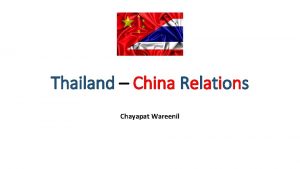History of Thailand n Thailand is located at








































































- Slides: 72

History of Thailand

n Thailand is located at Latitude 13 44 N and Longitude 100 30 E n Located in Southeast Asia

The Kingdom of Thailand n The kingdom of Thailand lies in the heart of Southeast Asia, Ø making it a natural gateway to Indochina, Myanmar and Southern China. n Its shape and geography divide into four natural regions : Ø Ø the mountains and forests of the North; the vast rice fields of the Central Plains; the semi-arid farm lands of the Northeast plateau; and the tropical islands and long coastline of the peninsula South

The Origin of Thais There are many different opinions or theory about the origins of Thais. • Originated in Northwestern Szechuan or Yunnan in China • Drawn from research done in Kwangtung, Kwangsi and Yunnan where is Thai Language still spoken. • From Central of China • Originated here in Thailand later scattered to various part of Asia

Early Kingdoms Central Thailand Dvaravati Lavo Northern Thailand Yonok Singhanavati Initial states of Thailand Hariphunchai Early history of Thailand BCE– 1238 ( Suvarnabhumi Southern Thailand Langkasuka Srivijaya Tambralinga

Sukhothai 13 th-15 th Century “ The dawn or the rising of happiness” * Por Khun Bang Klang Thao (Hao) the governor of Bang Yang and Por Khun Pha Muang the governor of Rad joined hand to crush the khmer rule. * Por Khun Bang Klang Hao declared independence in 1238 and was announced himself as king of Sukhothai name “Si Intrathit”

Sukhothai n King Si inthrathit and queen “Nang Suang” have 3 sons Ø Ø Ø The eldest was died when he was young The 2 nd was Ban Muang The 3 rd was Ram Khamhang who became the 3 rd King of Sukhothai

The Kings of Sukhothai King Pho Khun Sri Indraditya (1238 - 1257) 2. King Pho Khun Ban Muang (1277 - 1257) 3. King Pho Khun Ramkhamhaeng (Ramkhamhaeng the Great) (ruled 1277 - 1298 or 1317) (called Rammaraj in the Ayutthaya chronicles) * King Pu Phraya Si Songklam: After Ramkhamheang's death, ruled temporarily in absence of Loethai who was on trip to China. He was not styled Pho Khun. (Not 1. counted as a King)

The Kings of Sukhothai 4. 5. 6. 7. 8. 9. King Pho Khun Loeithai (1347 - 1298) King Pho Khun Nguanamthom (1347) King Phya Lithai or Thammaracha I (1368/1374 - 1347) King Thammaracha II or Phya Leuthai (1368/1374 - 1399) King Thammaracha III or Phya Saileuthai (1419 - 1399) King Thammaracha IV (1419 - 1438)

King Ramkhamhang • • • The 3 rd son of King Sri Inthrathit He ruled the kingdom with justice and great generosity to his people with the characteristic of a paternal government He invented the first Thai alphabet in 1283 by used the Mon and Khmer scripts which had been taken from Indian scripts as the basis of his alphabets.

King Ramkhamhang • • On one of his stone inscriptions it says “This Sukhothai is good. In the water there are fish. In the fields there is rice. The king doest not levy rate at his people. Who wants to trade in elephants trades. Who wants to trade in horses, trades. Who wants to trade in gold and silver, trades. The faces of the people shine bright. ”

King Maha Thammaracha I (Lithai)( 1346 -1374) n Who was remarkable for his religious piety. n He made a high monk a Sangkharacha (Supreme patriarch) n He set an example to his people by becoming a monk for a short time that was followed by Kings of Ayutthaya and King of the Chakri Dynasty. It became the custom for Thai young men aged 21 to enter the monkhood for at least a short period.

King Maha Thammaracha I (Lithai)( 1346 -1374) n Composed a book on Buddhist cosmology called “Tribhumikatha or Tribhum Phra Ruang( The three worlds – Heaven/Earth and Hell) n Making the Master Buddha image “Phra Puhttha Chinnarat” at Si Rattana Mahathat Temple in Phitsanulok.

The Fall of Sukhothai n After death of King Ramkhamhang, the Sukhothai tributaries n n broke away; (Uttaradit, Luang Prabang, Vientian, Mon, Tak, Supanburi). Sukhothai was quickly reduce the former power. Meanwhile since 1350 Ayuthaya was started the kingdom and rose in strength. Finally in 1378 King Thammaracha II had do submit to the power of Ayuthaya. Sukhothai Kingdom did not die a quick death. It’s decline lasted from the mid 14 th century until 15 th century.

Buddha Image in Sukhothai Style Characteristics of the image Ø “ A flame appeared on top of the Ø Ø head of the Buddha. The face is in the oval shape with the fine carving eyebrows. Eyes a bit open and downward gaze. Overall displays a gentle smiling expression. The Four postures of the buddha (sitting, standing, walking, reclining were created) Sukhothai religions art was influenced by Sri Lanka art

Lotus Bud Stupa n It is a very distinctive type of chedi found only in the towns that made up the inner provinces of the Sukhothai Kingdom such as Sukhothai, Kamphaeng Phet, Phetchabun and Phitsanulok. n It was simply emerged by an amalgamation of various contemporary art styles into a new style of a stupa, which become a common symbol of the Sukhothai community.

Lotus Bud Stupa n Estimated to have been built in the second half of the 14 th century n Commonly called the Lotus-Bud Tower due to the distinctive shape of the top; its proper name is phum khao bin.

Ayudhaya Kingdom n Existed from 1350 -1767 (417 years)until it was invaded by the Burmese n King Uthong moved the capital from Suphanburi or Uthong to the south to escape threat of an epidemic. n “Ayothaya” was settle before, and he founded a new capital, which he called “Ayuthaya” meaning the city of kings.

King Uthong King Ramathibodi I n He was the first king of the kingdom “Ayuthaya” reigning from 1350 -1369. n He was born in 1314 and known as Prince Uthong before ascended to the throne on March 4, 1350 n Possible to be related with “Lavo” Kingdom n Derived his name from Rama; the god Vishnu's reincarnation and the hero of Indian epic “Ramayana”

King Uthong King Ramathibodi I n During his reign the government adopted the form of an autocrat or absolute monarchy with strong Cambodian influences. n His autocracy was moderated by the observance of the ten Buddhist Kingly Duties. ( Todsaphit Ratchatam ) n King Uthong died in 1369 and his son “Ramesuan” mounted the throne.

Ayudhaya Kingdom n Reign with 33 Kings n from 5 Royal Dynasties Ø Ø Ø Uthong Suphannaphum Sukhothai Prasathong Ban Phu Luang

Kingdom of Ayutthaya (1350 -1767( Uthong Dynasty (first reign, 1350 -1370( Ramathibodi I (formerly Prince U Thong) (1350 - 1369) Ramesuan (1369 - 1370) (first rule, abdicated ( Suphannaphum Dynasty (first reign, 1370 -1388( Pha Ngua (Borommaracha Thirat I) (1370 - 1388) Thong Lan (1388) Uthong Dynasty(second reign, 1388 -1409( Ramesuan (1388 - 1395) (second rule) Ramracha Thirat (1395 - 1409)

Kingdom of Ayutthaya (1350 -1767( Suphannaphum Dynasty (second reign, 1409 -1569( 1) Intha Racha(Nakharinthara Thirat) (1409 - 1424 ( 2) Borommaracha Thirat II (Sam Phraya) (1424 - 1448) 3) Boromma Trailokanat (1448 - 1488) 4) Borommaracha Thirat III (1488 - 1491) 5) Ramathibodi II (Chettha Thirat) (1491 - 1529) 6) Borommaracha Thirat IV (Nor Phutthangkun) (1529 - 1533) 7) Ratsadathiratcha Kuman (1533); child king

Kingdom of Ayutthaya (1350 -1767( Suphannaphum Dynasty (second reign, 1409 -1569( 8) Chaiya Racha Thirat (1534 - 1546 ( 9) Kaeo Fa (Yot Fa) (joint regent 1546 -1548); child king & Queen Si Sudachan 10) Vạravoṇśādhirāj (1548 ( 11) Phra Maha Chakkraphat (ruled 1548 -1568) & Queen Suriyothai (d. 1548 ( 12) Mahinthara Thirat (1568 - 1569 (

Kingdom of Ayutthaya (1350 -1767( Sukhothai Dynasty (1569 -1629( 1) Maha Thammaracha Thirat (Sanphet I) (1569 - 1590 ( 2) Naresuan, the Great (Sanphet II) (1590 - 1605) 3) Eka Thotsarot (Sanphet III) (1605 - 1610) 4) Si Saowaphak (Sanphet IV) (1610 - 1611) 5) Drongdharm (Intha Racha) (1611 - 1628) 6) Chejthathraj (1628 - 1629) 7) Artitthayawongs (1629)

Kingdom of Ayutthaya (1350 -1767( Prasat Thong Dynasty (1630 -1688( 1) 2) 3) 4) Prasat Thong (Sanphet V) (1630 - 1655 ( Chao Fa Chai (Sanphet VI) (1655) Si Suthammaracha (Sanphet VII) (1655) Narai, the Great (1656 - 1688)

Kingdom of Ayutthaya (1350 -1767( Ban Phlu Luang Dynasty (1688 -1767( 1) 2) 3) 4) 5) 6) Phet Racha (1688 - 1703 ( Luang Sorasak or Phrachao Sua ('The Tiger King') (Sanphet VIII) (1703 - 1709) Tai Sa (Sanphet IX) ( (1733 - 1709 Borommakot (Borommaracha Thirat III) ( (1758 - 1733 Uthumphon (Borommaracha Thirat IV) (1758) Suriyamarin or Ekkathat (Borommaracha Thirat V) (1758 - 1767)

The 1 st Fall of Ayuthaya n In 1563 the successor of king Tabenshweti, King Burannong ascended the throne. n Ayuthaya was reign by King mahachakraphat; Known as “Lord of the white elephant” and his queen Suriyothai. n Appointed Khun Pirenthorathep as mahathammaraja to govern Phitsanulok

The 1 st Fall of Ayuthaya n Burmese King asked for 2 white elephants but King Mahachakraphat refused the request then Burmese King declared war in 1549. n Queen Suriyothai was died in the war n After 3 times serious combat with Burma, Thailand lost independence for the 1 st time in 1569 in the reign of King Mahintharathirat

Queen Sri Suriyothai n Means “Sunrise” n Queen of King Mahachakapat n Legendary queen for having givine herlife in defense of her king (as her husband) n In 2001; the movie “The legend of Suriyothai” was released”

King Naresuan or (Somdet Phra Sanpet. II) n He was born in Phitsanulok on 25 April, 1555 n He was the son of King Maha Thammarachathirat with his queen wisutkasatri (Daughter of Mahachakrapat & Queen Sri Suriyothai) n “Black Prince” Ø Supankanlaya – Golden Princess Ø Ekathatsarot – White Prince

King Naresuan n In 1563 King Burannong, King of Angwa invaded Siam and Phitsanulok became a Burmese tributary. n After the 1 st Fall of Ayuthaya, King Naresuan stayed 7 years in Angwa as a hostage. n In 1581 Burannong died and his son ascended the throne named “Nandaburan” n In 1584; declaration in independence

End of Ayuthaya n In 1758, King Ekkathat ascended to the n n throne King Uthumphon was forced to abdicate Ayuthaya was in the weakness period The lack of preparation and military training On April 7, 1767 Ayuthaya fell into Burmese hands. They were cruel to the Thais , burnt the city and many treasures both of material and cultural were destroyed

Kingdom of Thonburi (17681782) “Ayudhaya never lacks good man” Thonburi Dynasty (1768 -1782) n Taksin, the Great (28 December 1768 - 6 April 1782) n He was born in Thai-Chinese Family; Chinese father and Thai mother on 7 th April 1734. n The Samuhanayok adopted him and named him “Sin” which means money or property. n When he was 13 years old he became a royal page.

Kingdom of Thonburi (1768 -1782) n He was 3 years in monkhood from 20 years old. n Rejoined the service of king Ekathat who appointed him as Luang Yokabat n The governor of Tak known as “Phraya Tak” n He was promoted to Phra wichienprakan, the governor of Kamphangphet.

Kingdom of Thonburi (1768 -1782) n He was punished by King Ekathat because fired the cannon without the king’s permission. n Before the fall of Ayuthaya; he made his way out of the city directed to Chanthaburi, (passes ; Nakornayok, Chonburi and Rayong. ) n “To take the town by dawn and to throw away all the food reserves because they would have to take their meals inside the town or starve”

Kingdom of Thonburi (1768 -1782) n Came back to Ayuthaya after 7 months but too much was destroyed. n Established Thonburi Kingdom in 1767 and ascended the throne named “King Taksin” n In 1782 King Taksin was out of his mind, probably due to “the war strain and overwork arising from absolute rule” n He was killed by his soldier due to he was the insane king. n Thonburi was the capital for 15 Years.

The Rattanakosin Period 1782 -present Chakri Dynasty (1782 -Present( Name Born Died Reign start Reign end Buddha Yodfa Chulalok, the Great ( King Rama I) 1737 1809 6 April 1782 7 September 1809 Buddha Loetla Nabhalai (King Rama II) 1767 1824 7 September 1809 21 July 1824 Jessadabodindra (King Rama III) 1788 1851 21 July 1824 2 April 1851

Chakri Dynasty (1782 -Present( Name Born Died Reign start Reign end Mongkut (King Rama IV) 1804 1868 3 April 1851 1 October 1868 Chulalongkorn, the Great (King Rama V) 1853 1910 2 October 1868 23 October 1910 Vajiravudh ( King Rama VI) 1881 1925 23 October 1910 26 November 1925

Chakri Dynasty (1782 -Present( Name Born Died Reign start Reign end Prajadhipok ( King Rama VII) 1893 1941 26 November 2 March 1935 1925 (abdicated) Ananda Mahidol ( King Rama VIII) 1925 1946 2 March 1935 9 June 1946 Bhumibol Adulyadej, the Great ( King Rama IX) 1927 2016 9 June 1946 13 October 2016 Maha Vajiralongkorn Bodindradebayavarangkun 2016 - Present 13 October 2016 Present

The Rattanakosin Period Phraphutthayotfa Chulalok n The Great King Rama I 1782 -1809 "The Founder of Chakri Dynasty" n Jao Phraya Chakri , or Rama I, was the first King of Thailand's current Chakri royal dynasty ( April 6, 1782; Coronation Day) n He was born in 1736 and former name was “Thong Duang”

Phra Phutthayotfa Chulalok King Rama I n He entered the service of Phya Tak Sin and fought by his side in almost every campaign until the latter became King Tak Sin n His first order of business was to move the capital across the river from Thonburi to the east of chaopraya river n He built the Grand Palace complex of buildings, which included Wat Phra Kaeo to house the Emerald Buddha he captured from the Lao people in Vientiane. ( 3 years completed construction)

Restoration & Rebuilding King Rama I n n Ruled as an absolute monarch, , with the ten kingly virtues. He devoted himself to a reorganization of the administration. The Buddhist hierarchy was reorganized. The Buddhis scripture of Tripitaka was revised.

Restoration & Rebuilding King Rama I n Built and restored many temples, including Wat Phra Chetuphon or Wat Pho. n A commission of legal experts was set up to revise the laws and the result was the laws of Three Seals ( Kot Mai Tra Sam Duang) n Composed some poem “Ramakien”( Thai version of Ramayana) and “Inao”

The Burmese Keep Trying King Rama I n “Nine Armies Wars” (1785 -1786) Ø In 1785, nine Burmese armies totaling 144, 000 men crossed into Siam at five different points,

King Buddha Lertla Naphalai Rama II (1783 -1824) n King Rama I’s son. n A great poet n Golden age of Thai Literature. He wrote many epic poem for Thai classical drama, such as. “Sangthong” and also he collaborated with the other such as Sunthon Phu.

King Buddha Lertla Naphalai Rama II (1783 -1824) n He restored and ordered many temples to be built. The most famous was Wat Arun (The Temple of Dawn. But Rama III replaced the 52 foot central prang by a tower 227 feet high n And also shown his carving skill at the panel doors of the vihan (Prayer house) at Wat Suthat. n It was a reign of emphasizing the cultural aspects of life and, perhaps, not facing the hard choices ( Peaceful )

Sunthon Phu (1786 -1856) Ø He was born in June 26, 1786 Ø A favorite poet of King Rama II, because of his sharp wit and great artistic talents. Later Phu received the title of nobility as Khun Sunthonwohan. Ø He is one of the great of Thai literature. Ø Great poet for 4 Kingdoms (Rama I – IV) Ø His Popular story, “Phra Apaimani”, is a romantic epic which tells the adventures and love affairs of a prince

Phra Nang Klao King Rama III n He was born as prince “Tub”(Prince Chesadabodin) on March 31, 1788. n He was the son of King Rama II n King of Trade and was called by his father “Chao Sua” n The 1 st Newspaper was set up “The Bangkok Recorder” by Dr. Dan Beach Bradley; an American Christian Missionary

Phra Nang Klao King Rama III n Most of temples were adored with porcelain pieces from China due to the Trade with China. n Also order the pogoda from China to be built at Wat Yannawa in the shape of chinese boat. n Made Wat Pho an institution of high education n All the paintings and inscriptions were on small stone slabs and about many branches of study.

King Mongkut King Rama IV n He was in the monkhood for 27 years. n Ascended the throne when he was 47 years old. n Has a great knowledge of Budhism and developing the sect call Thammayut Nikaya. n Modernrization of the kingdom with truly well equipped. n Studied English from America Missionary n 1 st Asian Monarch who could understand, read and write English.

King Mongkut King Rama IV n Appointed Prince Chulamani, his younger brother, n n n as second King name Phra Pinklao Expanded the construction of the Grand Palace Sir John Bowring and The Bowring’s Proposal; a treaty of friendship and commerce. Was interested in astronomy and astrology Solar Eclipse August 18, 1868 at tambol Wa kor, Prachuap Khirikhan Province He was died of Malaria after came back from Prachuap-Khirikhan for 6 weeks when he was 64 years old.

King Chulalongkorn Rama V n He was born on September 20, 1853. n He ascended to the throne when he was 16 Years old. n Manage to save siam from being colonized and all his reforms were for the survival in the midst of western colonialism. n Was the 1 st Thai King who visit Europe twice. ( 1897 and 1907) n As shown in “Saded Prapat Ton” mixed and talked informally with his people n In 1905, he put out a law the abolition of slavery. This led to Thai people’s freedom.

King Mongkut King Rama V n The 1 st railway line from Bangkok to Nakhon Ratchasima with n n the first section to Ayuthaya. Built The marbel temple “Wat Benchamaborphit” Construction of “Chulalongkorn Equesterian Statue” for celebrated 40 years anniversary of the king. During his lifetime had 92 Royal consorts with 72 children He died in October 23, 1910 of his kidney disease in Dusit Palace when he was 58 years old with reigned the Kingdom for 43 years old.

King Vajiravudh Rama VI n He was born on January 1, 1881 and ruling from 1910 as a 6 th monarch of Chakri Dynasty. n He was firstly educated in Royal Palace in Siamese and English and continued his education in Britain at the “Royal Military Academy sandhurst” n Established Vajiravudh Colledge and Chulalongkorn University. n In 1991, he established the scout order in Siam.

King Vajiravudh Rama VI n In 1912, announced the change of calendar usage from Rattanakosin Era to Buddhist Era. n In 1914, Constructed Don Mueang Airport. n In 1915, Constuction of Hua Lamphong Rail Station.

King Vajiravudh Rama VI n In 1914 – 1918 World war I and promote “Siamese Nationalism” n In July 1917, King Vajiravudh sided himself with the Allied Powers and changed the flag of Siam from the elephant banner to a Tri-colors. n He died in November 25, 1925 when he was 46 years old and after his daughter only 1 day. His reign was 16 years long.

Thai Flag Aydhaya-1782 1917 - Present 1782 -1817/Rama I 1817 -1855/ Rama IV 1916 -1917 1855 -1916

King Prajadhipok Rama. VII (1925 -1934) He was born on November 8, 1893 Ascended to the throne on November 21, 1925 Last absolute Monarch Revolution on June 24, 1932 The 1 st permanent constitution was Promulgated on December 10, 1932 n The 1 st constitutional monarch n n

King Prajadhipok Rama. VII (1925 -1934) n March 2, 1935, King Prajadhipok abdicated and to be replaced by King Ananda Mahidol n After abdication, he spent the rest of his life in England with queen Ramphaiphanni n Built The Memorial Bridge ; The bridge was opened on April 6, 1932, commemorating the 150 th anniversary of the Chakri Dynasty. n Built the Sala Chaloem Krung (Chaloem Krung Royal Theatre)

King Ananda Mahidol Rama VIII (1934 -1946) n was born in Heidelberg, Germany , , September 20, 1925. He was the first son of Prince Mahidol Adulyadej of Songkhla (son of King Chulalongkorn) n On March 2, 1935 Prince Ananda Mahidol was elected by the Thai parliament and government to succeed his uncle, King Prajadhipok , , when he was only 9 years old n In 1938, at age 13, Ananda Mahidol visited the Kingdom of Siam for the first time as monarch. n On 10 December 1939, Revised the name from Siam to Thailand.

King Ananda Mahidol Rama VIII n He returned for a second visit in December 1945 after World War II with a degree in Law. n On June 9, 1946, the King was found shot dead in his bedroom in the Grand Palace only four days before he was scheduled to return to Switzerland

King Bhumibol Adulyadej Rama IX (1946 -2016) "We will reign with righteousness for the benefit and happiness of the Siamese people. " n Was born on December 5, 1927, in Cambridge, Massachusetts United States of America n He was the youngest son of Prince Mahidol of Songkhla, and the direct grandson of King Chulalongkorn (Rama V), and Queen Savang. n He has one older sister, Her Royal Highness Princess Galayani Vadhana of Naradhivas, and one older brother, His Majesty the late King Ananda Mahidol (Rama VIII).

King Bhumibol Adulyadej Rama IX Coronation “I shall reign with righteousness for happiness and benefit of the Siamese people” n His Majesty became King of the Kingdom on Thailand on 9 June 1946. n The Coronation Ceremony came later on 5 May 1950 at the Royal Palace in Bangkok, after His Majesty has finalized his education in Switzerland (changing from science to politic and law), where he met the HM Queen Sirikit.

King Bhumibol Adulyadej Rama IX Family n King Bhumipol and Queen Sirikit have 4 children n n (Formerly HRH) Princess Ubolrat HRH Crown Prince Mahavajiralongkorn HRH Crown Princess Maha Chakri Sirindhorn HRH Princess Chulabhorn Walailak

King Bhumibol Adulyadej Rama IX Monkhood n Following the death of his grandmother; Queen Savang Vadhana (Phra. Phanvasa Aiyeekajao Ø King Bhumipol entered a 15 days monkhood Ø from October 22 1956 – November 5, 1956 at Wat Bowonniwet Vihara.

King Bhumibol Adulyadej King Rama IX Talents n He is a man of many talents; musician, composer, painter, photographer, engineer , . etc. n He was a sailor who won the South East Asian Penninsula Games “Gold Medal in 1967”

King Bhumibol Adulyadej King Rama IX n The world’s longest serving Monarch n The Royal Barge Procession to celebrate the Diamon Jubilee 12 June 2006. n On 9 June 2006, King and Queen appeared on the balcony of Ananta Samakhom Throne Hall with more than 100, 000 Thai people were celebration. “Long Live His Majesty the King”

King Bhumibol Adulyadej King Rama IX n Royal Project Foundation, n Established in 1969 in the north of Thailand as originated from his majesty the kings private study to help the hill tribes to have a standard of living. n Royal Rain Making Project n Monkey Cheek’s Project n Sufficiency Economy n Etc. n The Waste Water aerator “Chai Pattana” with patented in 1993 n Royal Project

Present King n King Maha Vajiralongkorn Bodindradebayavarangkun

Assignment n Provide your knowledge of Sukhothai period. n Who is the second Great King in Thailand? Write about history. n Who said “Ayudhaya never lacks good man”? Write about history. n Provide your knowledge of Rattanakosin period.

 History also history physical
History also history physical Where is tailand
Where is tailand Vem (thailand) co., ltd.
Vem (thailand) co., ltd. Mahori country name
Mahori country name Swot thailand
Swot thailand Aging in thailand
Aging in thailand Hope rehab center thailand
Hope rehab center thailand 14thailand
14thailand Thai mythological creatures
Thai mythological creatures Aimsa thailand
Aimsa thailand Thailand gdp by sector
Thailand gdp by sector Thailand franchise association
Thailand franchise association Giscont
Giscont What thailand was previously known as
What thailand was previously known as Thailand halal logo
Thailand halal logo Tourism law thailand
Tourism law thailand Ren thailand
Ren thailand Nlp training thailand
Nlp training thailand Peta konsep perkembangan islam di malaysia
Peta konsep perkembangan islam di malaysia Fls 1993
Fls 1993 Thailand
Thailand Ren thai
Ren thai Thai care cloud
Thai care cloud Royal electronic factory
Royal electronic factory Mc donalds thailand
Mc donalds thailand Adra thailand
Adra thailand Crc thailand
Crc thailand Dilaka
Dilaka Culinary school in thailand for international students
Culinary school in thailand for international students The river rehab thailand
The river rehab thailand Amazing race records
Amazing race records Berikut adalah julukan bagi negara thailand, kecuali *
Berikut adalah julukan bagi negara thailand, kecuali * Thailand vision
Thailand vision Tourism law thailand
Tourism law thailand Thailand former name
Thailand former name Thailand sec
Thailand sec Jupiter logistics (thailand) co. ltd
Jupiter logistics (thailand) co. ltd Thailand fba anwälte
Thailand fba anwälte Thailand former name
Thailand former name Business opportunities in thailand
Business opportunities in thailand Delta electronics (thailand) pcl
Delta electronics (thailand) pcl Delmar international (thailand) co. ltd
Delmar international (thailand) co. ltd Szürkegém
Szürkegém Proper adjective for thailand
Proper adjective for thailand Pray for thailand
Pray for thailand Rotary youth exchange thailand
Rotary youth exchange thailand Breastfeeding thailand
Breastfeeding thailand Fulbright scholarship thailand
Fulbright scholarship thailand Weather warning thailand
Weather warning thailand Ihpp thailand
Ihpp thailand Renewable energy law thailand
Renewable energy law thailand Banyan tree krabi
Banyan tree krabi Onet thailand
Onet thailand Thailand bride price
Thailand bride price Hope rehab thailand
Hope rehab thailand Walter wintersteller
Walter wintersteller Stem cell or bone marrow transplantation thailand
Stem cell or bone marrow transplantation thailand Assumption primary school bangkok
Assumption primary school bangkok Office of agricultural economics thailand
Office of agricultural economics thailand Where was buddhism located in 1500
Where was buddhism located in 1500 Word nature organization
Word nature organization Where was troy located
Where was troy located Where were the sumerians
Where were the sumerians Patolli
Patolli Where are nonmetals located on the periodic table
Where are nonmetals located on the periodic table Where is the sahara located
Where is the sahara located Apical pulse
Apical pulse Where are feature detectors located
Where are feature detectors located Where was the mughal empire located
Where was the mughal empire located What is simple machine lever
What is simple machine lever Where is the citric acid cycle located in the mitochondria
Where is the citric acid cycle located in the mitochondria Virtual field trip amazon rainforest
Virtual field trip amazon rainforest Tropical rainforest ecosystem
Tropical rainforest ecosystem

